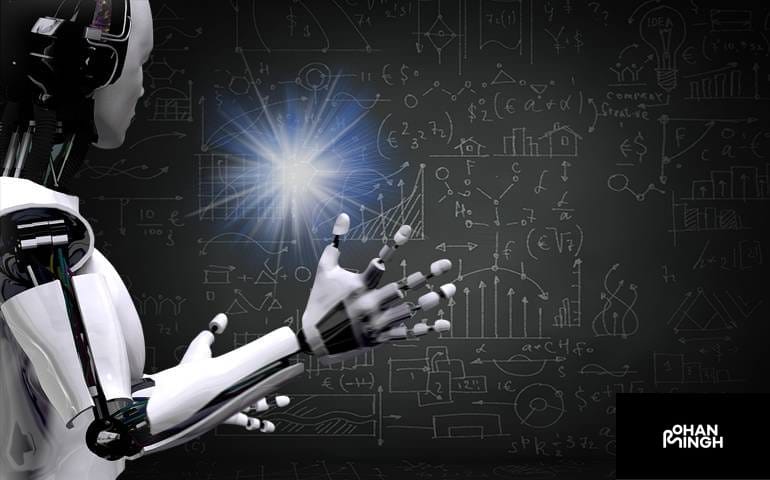How Can You Reset and Optimize Your ChatGPT for Unmatched Results?

What is ChatGPT?
ChatGPT, a state-of-the-art natural language AI chatbot developed by OpenAI, is revolutionizing the way we interact with technology. With its advanced machine learning algorithms, ChatGPT has the ability to understand and respond to human-like queries, making it an incredibly valuable tool for various applications.
Table of Contents
ToggleAt its core, ChatGPT is designed to generate accurate and coherent answers to a wide range of questions. Its functionality extends beyond basic information retrieval, as it can provide detailed explanations, opinions, and even engage in multi-turn conversations. This makes it an ideal solution for tasks such as drafting emails, writing code, answering trivia, offering product descriptions, and much more.
The algorithm powering ChatGPT is trained using a diverse range of data sources, allowing it to access a vast amount of information. By leveraging machine learning approaches, it continually improves its performance and adapts to user interactions. Its ability to generate high-quality answers while keeping the conversation flowing makes it an invaluable tool for users seeking instant and accurate information.
ChatGPT is a powerful natural language AI chatbot developed by OpenAI. Its ability to generate answers and provide information across a wide array of subjects makes it an indispensable tool in today’s digital landscape. Whether you need a quick response or a detailed explanation, ChatGPT is there to assist you every step of the way.
Understanding the Technology Behind ChatGPT
As an AI marketing expert, it’s crucial to grasp the technology behind ChatGPT in order to optimize its performance. ChatGPT utilizes a machine learning approach to generate accurate and coherent answers to a wide range of questions. Its algorithm is trained using diverse data sources, allowing it to access a vast amount of information and continuously improve its performance. This adaptive nature enables it to adapt to user interactions, making it an ideal tool for tasks such as drafting emails, writing code, and offering product descriptions. By leveraging the power of machine learning, ChatGPT provides users with instant and accurate information, ultimately enhancing the overall user experience.
Let's talk about your future project!
Eager to collaborate on your upcoming endeavor? Let's explore and ignite the potential of your next big idea, shaping a promising future together!
Machine Learning Approaches
Machine learning approaches have played a crucial role in the development and optimization of ChatGPT. One such approach is Bayesian machine learning, which focuses on updating prior beliefs based on new data to make more accurate predictions. By incorporating Bayesian machine learning techniques, ChatGPT can adapt its responses based on the context and user feedback, allowing for more personalized and relevant interactions.
Classical statistics tools are also employed in optimizing ChatGPT. These tools analyze large datasets to uncover patterns and relationships, helping to identify the strengths and weaknesses of the model. By leveraging classical statistics tools, developers can gain insights into the performance of ChatGPT and make informed decisions on how to improve it.
Furthermore, fine-tuning is a common technique used in machine learning to enhance the capabilities of models like ChatGPT. This process involves training the model on domain-specific data, allowing it to specialize and excel in particular tasks or knowledge areas. For instance, fine-tuning on medical diagnosis datasets can empower ChatGPT to provide more accurate and reliable healthcare-related information to users.
By incorporating Bayesian machine learning, classical statistics tools, and fine-tuning techniques, ChatGPT addresses its weaknesses and enhances its performance. These machine learning approaches enable the model to adapt to changing contexts, leverage statistical insights for improvement, and specialize in specific domains. Overall, the utilization of these methodologies ensures that ChatGPT provides users with more accurate and relevant responses.

Role of Artificial Intelligence (AI)
The role of Artificial Intelligence (AI) in the context of ChatGPT is pivotal. AI technology powers ChatGPT’s ability to generate text, code, and images quickly and accurately.
Through advanced machine learning algorithms and models, ChatGPT learns patterns and relationships from vast amounts of data. This enables it to understand and mimic human language, generating cohesive and contextually relevant responses.
AI technology allows ChatGPT to adapt and improve its performance over time. ChatGPT utilizes deep learning techniques to analyze and understand the content and context of the input it receives. It then uses this understanding to generate appropriate and coherent text-based outputs.
However, it’s important to acknowledge the weaknesses of ChatGPT. One limitation is the lack of a confidence level associated with its responses. While ChatGPT generates text, it does not provide an indicator of the certainty or accuracy of its answers. Additionally, ChatGPT’s responses are based on pre-existing information and lack the capability to retrieve “live” information from the internet or other sources.
To address these weaknesses, potential solutions can be considered. Bayesian machine learning models can provide a confidence level for the generated responses, enabling users to gauge the reliability of the information provided. Modern streaming architectures can facilitate the integration of live information sources, allowing ChatGPT to access up-to-date data. Lastly, fine-tuning the model with domain-specific examples can enhance its knowledge and accuracy in specific subject areas.
AI plays a crucial role in empowering ChatGPT to generate text, code, and images quickly. However, addressing weaknesses such as the lack of a confidence level and access to live information can be achieved through Bayesian machine learning models, modern streaming architectures, and fine-tuning techniques using domain-specific examples.
References to ChatGPT
When it comes to references to ChatGPT, it’s important to understand its usage and safety. OpenAI’s approach to utilizing chat data has greatly contributed to the advancement of natural language processing. By training the model on a wide range of conversations, ChatGPT has been able to learn patterns and context.
However, it is crucial to address potential privacy concerns that may arise from the usage of chat data. OpenAI has been diligent in ensuring the protection of user information and has implemented measures to safeguard privacy. Recent updates have even allowed users to hide chats from the sidebar, providing an additional layer of control over their data.
These references to ChatGPT highlight its versatility in various applications such as customer service, content creation, and even personal assistance. As users engage with ChatGPT, they can leverage its capabilities to generate personalized responses and improve overall user experience. The continuous development and optimization of ChatGPT demonstrate OpenAI’s commitment to enhancing its safety and reliability.
So, when it comes to references to ChatGPT, it’s essential to consider its usage and safety, OpenAI’s approach to chat data, the concern for user privacy, and the recent updates implemented to address these factors. By acknowledging these aspects, businesses and individuals can confidently utilize the power of ChatGPT for their specific needs.
Modern Designs and Features
Introducing the latest model from OpenAI, “text-davinci-003” for text generation and “code-davinci-002” for code generation, ChatGPT has leaped forward with remarkable advancements in modern designs and features. As of November 2022, these models have revolutionized the user experience by providing more accurate and comprehensive responses.
With the latest model, ChatGPT offers enhanced text generation capabilities, enabling it to generate more coherent and contextually relevant answers. This advancement is made possible by leveraging cutting-edge machine learning approaches and a vast amount of training data. As a result, users can expect more informative and engaging interactions with ChatGPT.
Moreover, the “code-davinci-002” model focuses specifically on code generation, catering to the needs of developers and programmers. This targeted approach ensures that ChatGPT can assist with various coding tasks, ranging from simple code snippets to complex programming solutions.
The integration of these latest models into ChatGPT has significantly improved its user experience. By harnessing the power of machine learning and state-of-the-art technologies, ChatGPT can better understand user queries, leading to more accurate and valuable responses. Whether it’s generating creative content, providing technical support, or assisting in problem-solving, ChatGPT’s modern designs and features elevate its performance to new heights.
The latest model in ChatGPT, “text-davinci-003” for text generation and “code-davinci-002” for code generation, showcase significant advancements that enhance the user experience. This includes improved text generation capabilities and specialized code generation functionalities, resulting in more accurate and comprehensive responses. By incorporating these modern designs and features, ChatGPT continues to lead the way in delivering high-quality and tailored interactions.

Identifying Areas for Improvement
In order to optimize and enhance the performance of ChatGPT, it is crucial to identify areas for improvement. By analyzing user feedback, data, and implementing various techniques, we can ensure that ChatGPT delivers even more accurate and valuable responses. In this article, we will explore different strategies and approaches to identify areas where ChatGPT can be further optimized, keeping user satisfaction and engagement at the forefront.
One of the primary ways to identify areas for improvement in ChatGPT is by analyzing user feedback and monitoring user interactions. By collecting and analyzing data on user queries, satisfaction levels, and common frustrations, we can gain insights into the specific areas that need attention. This feedback can be obtained through user surveys, reviews, and feedback mechanisms within the ChatGPT interface. Additionally, analyzing user interactions, such as the length of conversations and the number of iterations required to reach an accurate answer, can provide valuable insights into areas that may need improvement.
Furthermore, leveraging machine learning techniques and algorithms can help in identifying patterns and trends within user interactions. Natural Language Processing (NLP) algorithms can be applied to analyze chat logs and identify recurring issues or areas where the system may struggle. By pinpointing these areas, we can develop targeted solutions and interventions to address them effectively. Additionally, by leveraging sentiment analysis algorithms, we can identify any negative sentiment or frustration expressed by users, helping us understand where improvements are needed.
Another approach to identifying areas for improvement is by conducting usability testing and user research. This involves observing users while they interact with ChatGPT and gathering qualitative and quantitative data on their experiences. This could include monitoring the time taken to receive a response, the accuracy of the answer provided, and the overall ease of use. Through these observational studies, we can identify pain points, inefficiencies, and areas that may require further optimization.
Finally, benchmarking against competitors and industry standards can provide valuable insights into areas for improvement. By comparing ChatGPT’s performance against other AI chatbots and virtual assistants in the market, we can identify areas where ChatGPT may be falling behind or excelling. This analysis can help us understand where improvements need to be made to stay ahead of the competition and provide a superior user experience.
By analyzing user feedback, leveraging machine learning techniques, conducting usability testing, and benchmarking against competitors, we can identify areas for improvement in ChatGPT. This systematic approach ensures that the optimization efforts are targeted and effective, resulting in an enhanced user experience and improved performance of ChatGPT.
Dimensions of Behavior Change to Consider
Dimensions of Behavior Change to Consider in ChatGPT Optimization
When it comes to optimizing ChatGPT, it is important to consider the dimensions of behavior change. These dimensions play a crucial role in influencing the responses provided by ChatGPT and understanding them can help users achieve better results.
1. Knowledge: One dimension to consider is knowledge. ChatGPT should be trained on accurate and reliable information to provide users with correct answers. By ensuring that the AI model has access to up-to-date and relevant data, users can receive more accurate responses.
2. Motivation: Motivation is another important dimension to consider. ChatGPT should be designed to motivate users to take appropriate actions or make behavior changes. By delivering personalized and tailored messages, ChatGPT can encourage users to adopt positive behaviors and achieve their desired outcomes.
3. Skills: ChatGPT should also be optimized to enhance users’ skills. By providing actionable advice and guidance, the AI model can help users improve their capabilities and achieve better outcomes. This can be done through interactive features, such as step-by-step instructions or virtual demonstrations.
4. Social Support: Social support is an influential dimension of behavior change. ChatGPT can be designed to provide users with support and encouragement, simulating a human-like interaction. By fostering a supportive environment, users may feel more motivated and confident in their ability to make positive changes.
By considering these dimensions of behavior change in ChatGPT optimization, users can have a more personalized and effective experience. It is important to understand how each dimension can influence the responses provided by ChatGPT and utilize this knowledge to tailor the AI model for better results.
Resetting Your View of ChatGPT for Better Results
To optimize the performance and ensure better results from ChatGPT, it is essential to reset your view and adopt effective strategies. By utilizing machine learning approaches and incorporating behavior-change techniques, you can enhance the capabilities of ChatGPT to provide more accurate and relevant responses. This article will explore various approaches to resetting your view of ChatGPT, including the utilization of artificial intelligence tools and implementing behavior-change interventions, ultimately maximizing the potential of this innovative technology for improved outcomes. Whether it’s providing the correct answer or offering insightful recommendations, resetting your view of ChatGPT for better results is crucial for harnessing its power effectively.
1. Understanding the Machine Learning Approach:
To reset your view of ChatGPT and optimize its performance, it is essential to comprehend its underlying machine learning approach. By understanding how ChatGPT learns from data and adapts its responses, you can fine-tune the system to deliver more accurate and relevant answers. Utilize training data, evaluation metrics, and techniques like transfer learning to improve and personalize the performance of ChatGPT. Additionally, leveraging natural language processing tools and applications can significantly enhance the conversational abilities of ChatGPT.
2. Implementing Behavior-Change Techniques:
To steer ChatGPT towards better results, incorporating behavior-change interventions is crucial. Borrowing from the field of psychology, interventions can be applied to modify and optimize the behavior-change dimensions of ChatGPT. Utilize 8 behavior-change interventions, such as goal setting, feedback and evaluation, risk assessment, and continuous learning, to enhance the system’s abilities to provide accurate and helpful responses. By applying these techniques, ChatGPT can adapt to user needs, offer more informed recommendations, and exhibit improved conversational skills.
3. Leveraging Artificial Intelligence Tools and Applications:
Maximizing the potential of ChatGPT for better results involves leveraging artificial intelligence tools and applications. Explore cutting-edge technologies, such as natural language processing models, to enhance the system’s comprehension and ability to generate accurate responses. By utilizing advanced AI tools and applications, you can fine-tune ChatGPT’s capabilities, improving its accuracy, relevance, and overall performance.
By resetting your view of ChatGPT and adopting effective strategies, you can optimize its performance for better results. Understanding the machine learning approaches, implementing behavior-change techniques, and leveraging artificial intelligence tools and applications are key steps toward enhancing ChatGPT’s capabilities. Stay ahead of the competition and harness the power of ChatGPT optimization to unlock its full potential for improved user experiences and outcomes.

Final Thoughts
ChatGPT optimization is crucial in unleashing the full potential of this innovative technology. By adopting effective strategies and harnessing the power of machine learning approaches, behavior-change techniques, and artificial intelligence tools, we can enhance the performance and achieve better results with ChatGPT.
Recent progress in computer vision has opened doors to numerous applications, especially in healthcare institutions and enterprises. Computer vision, powered by Convolutional Neural Networks (CNNs), enables accurate diagnosis, monitoring, and treatment planning in healthcare. It revolutionizes enterprises’ operations by automating tasks, improving security, and enhancing customer experiences. The integration of computer vision with ChatGPT optimization can significantly amplify its capabilities in these domains.
To capitalize on the vast machine learning opportunities, it is vital to pursue realistic projects and upskill in the field. Identifying real-world problems and creating practical solutions using machine learning can lead to tangible results. Upskilling in machine learning techniques, such as deep learning and data analysis, equips individuals and organizations to navigate the evolving landscape and leverage the power of ChatGPT optimization effectively.
ChatGPT optimization opens new avenues for improved performance and better outcomes. Leveraging recent advances in computer vision and healthcare applications, along with enterprises’ requirements, can unlock the full potential of ChatGPT. By embracing realistic projects and upskilling, we can capitalize on the vast opportunities offered by machine learning and reshape the future.
FAQ's
What is ChatGPT Optimization?
ChatGPT Optimization refers to the process of improving the performance and results obtained from ChatGPT, an innovative technology powered by machine learning approaches. By adopting effective strategies and techniques, ChatGPT can be fine-tuned to provide more accurate and relevant answers to users’ queries.
How does ChatGPT utilize machine learning approaches?
ChatGPT utilizes machine learning approaches, particularly deep learning techniques, to analyze and understand the input provided by users. It learns from vast amounts of data to generate appropriate responses and provide valuable insights. This learning process helps ChatGPT continuously improve its knowledge and performance over time.
Can ChatGPT support behavior-change interventions?
Yes, ChatGPT has the potential to support behavior-change interventions. Through its advanced natural language processing capabilities, it can provide personalized guidance, recommendations, and information to individuals seeking behavior change. By utilizing behavior-change techniques and leveraging the power of machine learning, ChatGPT can assist users in achieving their goals.
What are the dimensions of behavior change that ChatGPT addresses?
ChatGPT addresses various dimensions of behavior change, including knowledge, motivation, self-efficacy, goals, social support, emotions, habits, and environment. By incorporating these dimensions into its responses and recommendations, ChatGPT can effectively assist individuals in making positive behavior changes.
How can ChatGPT Optimization be applied in different industries?
ChatGPT Optimization can bring remarkable benefits to industries such as healthcare, customer service, education, and e-commerce. By fine-tuning ChatGPT according to the specific needs of these industries, it can provide personalized recommendations, support decision-making processes, and enhance user experiences.
Similar articles about Activation Strategy:
Ready to Revolutionize Your Resume with ChatGPT, Your AI-Powered Resume Helper?, Can Anthropic's New Claude AI Outshine ChatGPT?, Want to Level-Up Your Performance Max Campaigns with Google Apps Script?, Transform Your Marketing Strategies with AI: How and Why?
How Can You Harness the Power of AI and Still Safeguard Your Privacy?, Can You Revolutionize Fictional Worldbuilding Using ChatGPT?, Want to Master YouTube SEO in 2023? Boost Your Rankings with These Tips!, How Can You Reset and Optimize Your ChatGPT for Unmatched Results?
What Marketing Strategy Did Cheetos Employ for Plants vs. Zombies Collaboration?
Rohan Singh | May 1, 2024 | Acquisition What Marketing Strategy Did Cheetos Employ for Plants vs. Zombies Collaboration? Background on Cheetos Cheetos, a popular brand of cheese-flavored snacks, has made a name for itself with its bold and playful marketing strategies. Known for its irreverent and creative campaigns, Cheetos has consistently found unique ways […]
What Marketing Strategy Did Cheetos Employ for Plants vs. Zombies Collaboration?
Rohan Singh | May 1, 2024 | Acquisition What Marketing Strategy Did Cheetos Employ for Plants vs. Zombies Collaboration? Background on Cheetos Cheetos, a popular brand of cheese-flavored snacks, has made a name for itself with its bold and playful marketing strategies. Known for its irreverent and creative campaigns, Cheetos has consistently found unique ways […]
What Differentiates Differentiated Marketing Strategy from Undifferentiated?
Rohan Singh | April 30, 2024 | Acquisition What Differentiates Differentiated Marketing Strategy from Undifferentiated? Definition of Differentiated Marketing Strategy A differentiated marketing strategy is a targeted approach that focuses on creating unique products or services to meet the specific needs and preferences of different customer segments. It recognizes that customers have diverse tastes, preferences, […]
What Sets Apart the Marketing Concept from a Marketing Strategy?
Rohan Singh | April 29, 2024 | Acquisition What Sets Apart the Marketing Concept from a Marketing Strategy? Definition of Marketing Concept The marketing concept is a philosophy that places the customer at the center of all marketing activities. It focuses on understanding the needs and wants of the target market and delivering value to […]
Which promotional mix strategy targets market channel members?
Rohan Singh | April 28, 2024 | Acquisition Which promotional mix strategy targets market channel members? When it comes to promoting a product or service, companies utilize various strategies to reach their target audiences. One key strategy that directs marketing efforts toward market channel members is known as trade promotion. Trade promotion is a type […]
Should charter schools adopt regional or national marketing strategies?
Rohan Singh | April 27, 2024 | Acquisition Should charter schools adopt regional or national marketing strategies? Purpose When it comes to marketing strategy in the field of charter schools, two broad approaches can be taken: regional and national. Each approach has its purpose and benefits depending on the goals and aspirations of the charter […]
Topics :
Share :






